It looks like you're using an Ad Blocker.
Please white-list or disable AboveTopSecret.com in your ad-blocking tool.
Thank you.
Some features of ATS will be disabled while you continue to use an ad-blocker.
12
share:
[NOAA Ship Explores Undersea Volcano More Than 10,000-ft. High, Maps Indonesian Ocean Seafloor]
During the past few weeks, one of the world's larges submerged volcano was mapped and explored in detail for the first time by a joint Indonesian/U.S. expedition north of the island of Sulawesi.
Indonesian and U.S. scientists believe that investigating previously unexplored ocean areas will yield new phenomena and provide information that will improve understanding of ocean ecosystems, ocean acidification and climate change impacts.
Back-story:
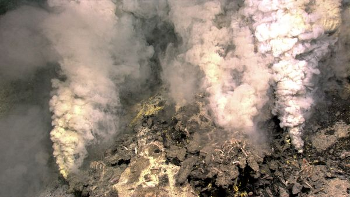 “This is a huge undersea volcano, taller than all but three or four
mountains in Indonesia, and rising more than ten thousand feet from the seafloor in water more than eighteen thousand feet deep,”
“This is a huge undersea volcano, taller than all but three or four
mountains in Indonesia, and rising more than ten thousand feet from the seafloor in water more than eighteen thousand feet deep,”
“The more we understand these undersea features and the communities of life they support, the better we can manage and protect the ocean and its resources.”
Jim Holden, U.S. chief scientist... (2)
Maiden Voyage
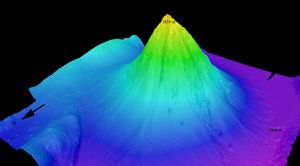
This is a perspective view of the Kawio Barat (West Kawio) seamount looking from the northwest. The underwater volcano rises around 3,800 meters from the seafloor.
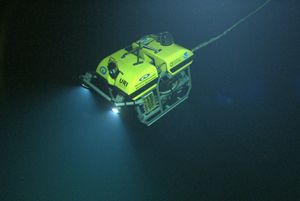
IFE's Little Hercules ROV descends down to the summit of the Kawio Barat submarine volcano.
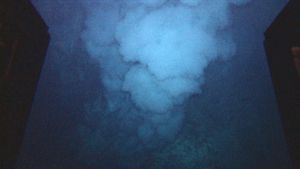
The IFE's Little Hercules ROV images a vent plume as it descends to the summit of Kawio Barat submarine volcano.
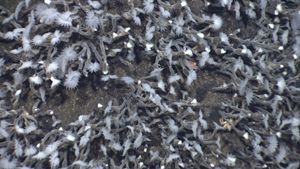 Close-up imagery showing barnacles covering sulphur structures on Kawio
Barat volcano. Their tentacles, or ‘cirri,’ extended like blooming flowers, then folded back into the shell. The white fluff on the cirri are
filaments of bacteria that grow in the passing vent water. The barnacles hold them out to improve growth then, apparently, withdraw to “lick their
fingers.”
Close-up imagery showing barnacles covering sulphur structures on Kawio
Barat volcano. Their tentacles, or ‘cirri,’ extended like blooming flowers, then folded back into the shell. The white fluff on the cirri are
filaments of bacteria that grow in the passing vent water. The barnacles hold them out to improve growth then, apparently, withdraw to “lick their
fingers.”
[edit on 18-7-2010 by LadySkadi]
During the past few weeks, one of the world's larges submerged volcano was mapped and explored in detail for the first time by a joint Indonesian/U.S. expedition north of the island of Sulawesi.
Indonesian and U.S. scientists believe that investigating previously unexplored ocean areas will yield new phenomena and provide information that will improve understanding of ocean ecosystems, ocean acidification and climate change impacts.
Back-story:
Mining companies first spotted the Kawio Barat volcano in the 1990s with satellite altimetry. But "we were the first to go there with a [remotely operated vehicle] and actually discover hydrothermal fluids coming out of the volcano," microbiologist Jim Holden, chief U.S. scientist for the Kawio Barat expedition, said in an email. (1)
 “This is a huge undersea volcano, taller than all but three or four
mountains in Indonesia, and rising more than ten thousand feet from the seafloor in water more than eighteen thousand feet deep,”
“This is a huge undersea volcano, taller than all but three or four
mountains in Indonesia, and rising more than ten thousand feet from the seafloor in water more than eighteen thousand feet deep,” “The more we understand these undersea features and the communities of life they support, the better we can manage and protect the ocean and its resources.”
Jim Holden, U.S. chief scientist... (2)
Maiden Voyage
Scientists chose Kawio Barat as the first target for the expedition based on satellite information and data collected by a joint Indonesian-Australian team in 2004. The immense underwater feature served as an ideal initial target to calibrate onboard tools and technologies being used on the ships maiden voyage. Expedition scientists hope the maps and video produced from the expedition will pave the way for other researchers to follow up on their preliminary findings.

This is a perspective view of the Kawio Barat (West Kawio) seamount looking from the northwest. The underwater volcano rises around 3,800 meters from the seafloor.

IFE's Little Hercules ROV descends down to the summit of the Kawio Barat submarine volcano.

The IFE's Little Hercules ROV images a vent plume as it descends to the summit of Kawio Barat submarine volcano.
 Close-up imagery showing barnacles covering sulphur structures on Kawio
Barat volcano. Their tentacles, or ‘cirri,’ extended like blooming flowers, then folded back into the shell. The white fluff on the cirri are
filaments of bacteria that grow in the passing vent water. The barnacles hold them out to improve growth then, apparently, withdraw to “lick their
fingers.”
Close-up imagery showing barnacles covering sulphur structures on Kawio
Barat volcano. Their tentacles, or ‘cirri,’ extended like blooming flowers, then folded back into the shell. The white fluff on the cirri are
filaments of bacteria that grow in the passing vent water. The barnacles hold them out to improve growth then, apparently, withdraw to “lick their
fingers.” [edit on 18-7-2010 by LadySkadi]
Interesting information. Thanks for sharing.
One thing I noticed that struck me as odd, was the shape of the volcano.
I am not a volcanologist, but I am not used to seeing volcanoes shaped this way.
This one here is shaped like a full cone. Most Volcanoes I have seen on land, are shaped like a cone that had it's tip cut off, leaving a crater.
And from what I gather, aren't these craters caused by massive eruptions ?
So does that mean that Kawio Barat has not had a large eruption in a super long time? Since the tip of the mountain has not blown off yet and formed cratering?
I am not a geologist so anyone who actually knows the answers to these questions (or even just has a theory or comment), feel free to answer them.
I am open to any ideas you folks have, and I am looking forward to learning about it.
One thing I noticed that struck me as odd, was the shape of the volcano.
I am not a volcanologist, but I am not used to seeing volcanoes shaped this way.
This one here is shaped like a full cone. Most Volcanoes I have seen on land, are shaped like a cone that had it's tip cut off, leaving a crater.
And from what I gather, aren't these craters caused by massive eruptions ?
So does that mean that Kawio Barat has not had a large eruption in a super long time? Since the tip of the mountain has not blown off yet and formed cratering?
I am not a geologist so anyone who actually knows the answers to these questions (or even just has a theory or comment), feel free to answer them.
I am open to any ideas you folks have, and I am looking forward to learning about it.
Neat thread,
10,000 feet is a pretty serious hump. Would be interesting to compare the pressures of these vents with the GOM leak, but I don't want to hijack the thread...
I think the shape of the cone develops like that under the ocean as it lacks the usual processes of erosion that we see on land, but I'm no expert at all.
10,000 feet is a pretty serious hump. Would be interesting to compare the pressures of these vents with the GOM leak, but I don't want to hijack the thread...
I think the shape of the cone develops like that under the ocean as it lacks the usual processes of erosion that we see on land, but I'm no expert at all.
reply to post by LadySkadi
S & F
This thread is EPIC.
So what are your thoughts of underwater life elsewhere in the solar system? You know, possible life on the outlying ice moons of the gas giants around underwater volcanic smokers?
[edit on 18-7-2010 by SLAYER69]
S & F
This thread is EPIC.
So what are your thoughts of underwater life elsewhere in the solar system? You know, possible life on the outlying ice moons of the gas giants around underwater volcanic smokers?
[edit on 18-7-2010 by SLAYER69]
reply to post by twitchy
Yep. Thought about it myself, when I was reading the articles. The story is about not only the volcano itself, but also the technology NOAA is using to map unknown parts of the ocean floor. I don't see it as too far off topic to wonder...
Would be interesting to compare the pressures of these vents with the GOM leak,
Yep. Thought about it myself, when I was reading the articles. The story is about not only the volcano itself, but also the technology NOAA is using to map unknown parts of the ocean floor. I don't see it as too far off topic to wonder...
Its pretty amazing news really, i posted the very same to a thread here on ATS.
Originally posted by SLAYER69
reply to post by LadySkadi
So what are your thoughts of underwater life elsewhere in the solar system? You know, possible life on the outlying ice moons of the gas giants around underwater volcanic smokers?
Sure, why not? It's been demonstrated over and over again, each time we make a new discovery and with it find life in a place we didn't before know it to be, that it's is quite adaptable and if there is a way, life will find it...
How active is this at this moment? Im asking because the Earthquake activity on this plate is picking up. Anyone checked usgs lately?
reply to post by LadySkadi
Quality information Lady Skadi,and very well presented.
The wonders of the deep just keep on coming.
There are actual communities of lifeforms living because of that volcano.
Totally awesome stuff IMO!
Its a whole different world down there.
Quality information Lady Skadi,and very well presented.
The wonders of the deep just keep on coming.
There are actual communities of lifeforms living because of that volcano.
Totally awesome stuff IMO!
Its a whole different world down there.
I think the article in NatGeo answers that somewhat:
Originally posted by muzzleflash
One thing I noticed that struck me as odd, was the shape of the volcano.
I am not a volcanologist, but I am not used to seeing volcanoes shaped this way.
This one here is shaped like a full cone. Most Volcanoes I have seen on land, are shaped like a cone that had it's tip cut off, leaving a crater.
And from what I gather, aren't these craters caused by massive eruptions ?
So if it has frequent smaller eruptions, the lava can leak out and form that cone shape instead of blowing the top off. There have to be openings the lava can pass through, where they see the hydrothermal vents.
"There is fairly fresh-looking volcaniclastic sediment covering the top of Kawio Barat, and the steep, smooth slopes of the volcano suggest that it has experienced recent eruptions,
Apparently Loihi, the underwater volcano forming the next island in Hawii's chain had a sharper peak, and lost it when it collapsed:
submerged mountain Loihi collapses
(1996 article)
So if I'm reading that right, it wasn't an eruption that formed the crater in the previously cone-shaped top, it was instead, a collapse. But apparently they didn't see it happen so I'm not sure.
The underwater volcano growing off Hawaii's south coastline collapsed partially during the summer, according to a team of oceanographers scouting the shattered peak from a deep-sea submersible. The cave-in has provided scientists with an unprecedented glimpse into the often tumultuous process that gradually builds up volcanic islands from the ocean floor.
Malahoff and his colleagues first tried to dive to Loihi in August, but they found the water too turbulent. When they returned in late September, the scientists attempted to visit Loihi's peak, a region named Pele's Vents for its superheated geysers surrounded by a rich community of microorganisms. What they found in its place was a new crater.
"This large hole, three-quarters of a mile in diameter, didn't exist before.
Now it looks more like what you'd expect to see, after the collapse, right?
wapedia.mobi...
[atsimg]http://files.abovetopsecret.com/images/member/8328f158e19d.jpg[/atsimg]
Pretty cool stuff!
[edit on 19-7-2010 by Arbitrageur]
new topics
-
The trial on kids was stopped
Medical Issues & Conspiracies: 32 minutes ago -
Orbs Appear And Form Triangle On Live Cam.
Aliens and UFOs: 2 hours ago -
Biden Has New Bizarre Injuries to His Face
Politicians & People: 3 hours ago -
Something is not adding up in regards to the H-1B commotion
General Conspiracies: 4 hours ago -
Elon Musk Calls for Tommy Robinson to be Freed - and Takes a Dig at Starmer
Politicians & People: 4 hours ago -
Biden to award Presidential Citizens Medal to Liz Cheney and Bennie Thompson
US Political Madness: 5 hours ago -
Just learned a really helpful trick for internet searches
Computer Help: 10 hours ago
top topics
-
Biden Has New Bizarre Injuries to His Face
Politicians & People: 3 hours ago, 10 flags -
Biden to award Presidential Citizens Medal to Liz Cheney and Bennie Thompson
US Political Madness: 5 hours ago, 9 flags -
Just learned a really helpful trick for internet searches
Computer Help: 10 hours ago, 7 flags -
Not off to a good start
General Chit Chat: 12 hours ago, 6 flags -
Elon Musk Calls for Tommy Robinson to be Freed - and Takes a Dig at Starmer
Politicians & People: 4 hours ago, 5 flags -
Something is not adding up in regards to the H-1B commotion
General Conspiracies: 4 hours ago, 5 flags -
Orbs Appear And Form Triangle On Live Cam.
Aliens and UFOs: 2 hours ago, 3 flags -
The trial on kids was stopped
Medical Issues & Conspiracies: 32 minutes ago, 2 flags
active topics
-
How we've changed in 100 years
Ancient & Lost Civilizations • 34 • : Flyingclaydisk -
Orbs Appear And Form Triangle On Live Cam.
Aliens and UFOs • 3 • : BeyondKnowledge3 -
Vehicle Strikes people in New Orleans
Mainstream News • 277 • : Flyingclaydisk -
Tesla Cybertruck Explodes in Front of Trump Hotel in Las Vegas
Mainstream News • 111 • : Flyingclaydisk -
The trial on kids was stopped
Medical Issues & Conspiracies • 0 • : annonentity -
-@TH3WH17ERABB17- -Q- ---TIME TO SHOW THE WORLD--- -Part- --44--
Dissecting Disinformation • 3895 • : IndieA -
Strange fog all over the northern hemisphere
General Conspiracies • 43 • : annonentity -
The Acronym Game .. Pt.4
General Chit Chat • 1033 • : tinkerbell99 -
Ukraine halts transit of Russian gas to Europe after a prewar deal expired
Political Conspiracies • 111 • : Oldcarpy2 -
Post A Funny (T&C Friendly) Pic Part IV: The LOL awakens!
General Chit Chat • 7979 • : chiefsmom
12
